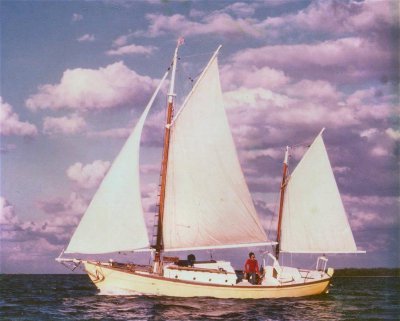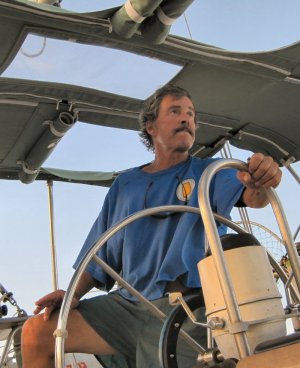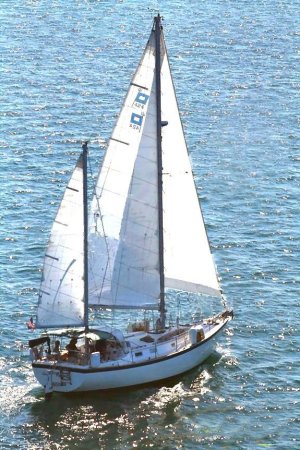|
|
|
.
|
.

|
.
|
Story by Tor Pinney
Back to List of Tor's Tales
Engineless
© 2012 Tor Pinney - All Rights Reserved
Lessons Learned Between a Rock and a Hard Place
|
"The technique of
cruising under sail alone is very different from, and
much more interesting than, cruising under sail with
the knowledge that beneath the cockpit floor is a
power unit which... (can) spring to life and whisk one
away from dangerous or difficult situations. Without
the help of an auxiliary one has to study carefully
the tidal streams and insets, just as our grandfathers
used to, and jockey for position so that should the
wind fail at a vital moment the yacht is not
endangered... Above all one has to learn to be
patient."
.
-- Eric Hiscock, Wandering Under
Sail (ca. 1939)
"It is not until
one has sailed of necessity without an engine that it
is possible to realise what can be done under sail
alone."
.
-- Eric Hiscock,
Wandering Under
Sail (ca. 1945) |
|
Back in the day, I owned a salty
gaff-rigged ketch named Autant. Traditional to a fault,
she had no electricity, plumbing, winches, roller
furling or any other modern conveniences. No engine,
either, and there were plenty of times I wished it were
otherwise. But like it or not, those years I spent
cruising engineless were emphatically educational. Not
only did I learn a shipload of sailing techniques, but
also the value of careful planning, extra caution and
above all, patience; ‘When the wind don’t blow, the boat
don’t go.’
|
 |
 |
In the decades since then
I’ve skippered and owned a variety of blue water sailboats,
all of them with auxiliary engines. Like most modern
sailors, I grew to rely on “the iron jenny,” using it not
only when necessary, but often when merely convenient.
However, all that changed one recent afternoon while I was
single-handing my 42’ ketch, Silverheels, up through the
Exumas.
I’d been motor-sailing all day in light airs. Late in the
afternoon, as I approached a cut leading to the lee side of
the island chain, I rolled up the genoa and dropped & furled
the mainsail; they weren’t helping much anyway. Like most
skippers I have my own ways of squaring away the rig:
mainsail tightly furled and lashed with 3 sail ties, sheets
and furling line coiled & hung, halyards secured away from
the masts and so on. By the time I powered through the cut
against the strong ebb tide, all that remained was to put on
the sail cover once I was anchored. Very shipshape and
orderly, but as I was about to be reminded, all wrong. |
Through the cut, around a point and into a long, narrow
channel leading to the remote anchorage that would be home
for the night, now motoring into the light breeze as well as
the tide. Suddenly I felt the boat slowing down. Hmmm, odd.
I gave her a little more throttle, but she slowed even more.
It took a moment to realize I was no longer getting
propulsion from the engine; the transmission wasn’t engaging
the gears. I had no forward or reverse, just neutral.
The water was shallow enough to anchor right there, but it
was an awkward, exposed place, too narrow for swinging,
bordered by a coral rock shoreline to port and what the
chart labeled “Hard Grassy Shoals” to starboard. No, I
needed to get to the anchorage, then I’d figure out what was
wrong with the transmission. Meanwhile, the current was
already starting to push us backwards while the breeze,
close off the starboard bow, nudged the boat steadily closer
to the shore. I needed steerage, and for that I had to get
the boat sailing RIGHT NOW.
I rolled out the genoa - that was the quickest sail to set -
although I had to first free up the coiled, wrapped & hung
furling line and sheets. Silverheels fell off and got
moving, just enough to steer and almost stem the current.
Now we had to come about and get away from the shore, but
with hardly any headway or wind and no sail aft, I wasn’t
sure she would make the tack. She didn’t. I put the helm
over and almost got the jenny to backwind, but the boat
stalled and then fell off again, straight towards the
shoreline. There wasn’t time to try again, nor room to fall
off and jibe. Another 30 seconds and we’d ground on the
coral.
QUICK, DO SOMETHING!
Just then I recalled an old trick from my engineless Autant
days. Sprinting forward, I let go an anchor in record time,
speed-fed some chain after it, made it fast and positively
willed the hook to grab as Silverheels dragged it sideways
toward the rocks. And grab it did, just in time and just
enough to coax the bow around onto the port tack, away from
the shore. But we’d come awfully close.
Retrieve the anchor, dash to the cockpit, tack the backed
jenny and sheet it in... By the time Silverheels was making
way again she was coming up on the hard shoal on the other
side of the channel. I needed her to point higher, move
faster and tack more assertively. I needed the mainsail.
Thank goodness I hadn’t covered it! Still, it took precious
time to strip off the sail ties, free the halyard, raise the
sail, get back to the cockpit and sheet it in. Silverheels
instantly pointed higher and gained a knot or more. There
were only inches under the keel when I tacked her back
towards the coral again. My heart was pumping faster than a
pole dancer on ecstasy.
It quickly became evident that even with full sail we
weren’t going to conquer that current in such tight quarters
and so little wind. In the end I had to fall off, backtrack
through the channel and then sail far out onto the banks,
dodging coral heads and shoals in the waning light. At last,
a long hour later, we came into the anchorage from the other
side. Home is the sailor.
The problem turned out to be the transmission oil cooler.
Though only a few years old, it had failed, flushing out the
transmission fluid with seawater. I needed a new one and the
nearest was 500 miles away in Florida. I’d have to get
somewhere civilized to order the part and receive it. Until
then I was sailing an engineless boat – just like the old
days.
|
The next morning I sailed off anchor for the first time in a
long time. The ebb whisked us through the narrow channel and
back out the cut into Exuma Sound. The wind cooperated, too,
with a steady 15 knots from the ESE. We reached up the
Exumas on the outside and then caught a rising tide through
another cut onto the banks, making for a town farther up the
line. Black Point settlement would provide not only an
internet connection so I could order the part and regular
air service to fly it in, but also protection from a strong
cold front forecast to arrive the next day. |
 |
|
 |
Cruising engineless again after so many years triggered
a series of flashbacks, recalling techniques and a mind
set I hadn’t used in years. Yesterday I could just fire
up the engine and power through pretty much anything.
Today wind strength and direction, currents, tacking
room and a host of other details became all important. I
had to pay closer attention, plan tactics and passages
more carefully in advance, be certain my boat fell off
towards open water when weighing anchor rather than
towards the shore or another boat, catch an ebb tide to
exit a cut and a flood tide to enter one, avoid narrow
channels to windward and harbors without sufficient
maneuvering room, always have an escape plan and above
all sail my boat like it mattered – because it did. It
was challenging, exciting and gratifying all at once.
We
made Black Point without mishap, sailing smartly into
the broad harbor under jib & jigger and anchoring at its
head in anticipation of the coming front. Then, because
it was forecast to blow 35 knots, I set a second anchor
using a headsail (in lieu of the engine) to position the
boat, another technique recalled from my Autant days. It
was pretty cool. The skipper from a nearby boat even
came by to say how impressive it was to see someone
actually sail into an anchorage for a change. I didn’t
mention I’d had no choice. |
The front came and went;
the new transmission oil cooler was ordered, shipped,
received and installed. A week after arriving engineless,
Silverheels departed with power restored, but I didn’t motor
out of the harbor. I sailed out.
Loosing my engine for a while had reminded me of how
important it is to remain proficient at pure sailing, to
know your boat’s capabilities and limitations and your own.
It also reminded me of how much fun it is! Now I tend to
plan passages as if I had to sail them, and more often than
not I do. Most days I sail on and off the anchor, just for
fun and to keep in practice. If I do drop the sails to enter
a difficult port, I don’t square away the rig until later,
after the anchor is set. Until then I leave lines coiled but
ready to run, not wrapped & hung. The mainsail is furled but
lying loose in the lazy jacks, not bound with sail ties,
ready to hoist instantly if needed, its halyard likewise on
standby. The mizzen usually stays up for anchoring whether
under sail or power. It holds the bow to the wind when the
boat backs down on the rode, but can also serve as the after
half of a balanced sail plan should I suddenly have to roll
out the genoa and resume sailing.
A reliable engine is a wonderful tool, but using mine less
has added a refreshing dimension to my cruising, or maybe
just reawakened it. Certainly it has made me a safer, better
sailor - almost as good as I was back when I cruised
engineless full time aboard the ketch Autant.
~ End ~
Back
to List of Tor's Tales
|
|
|